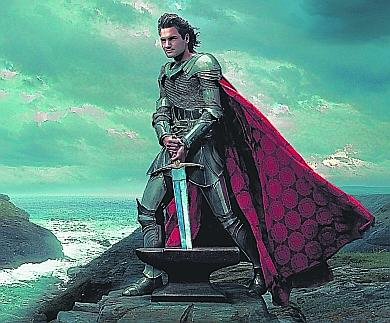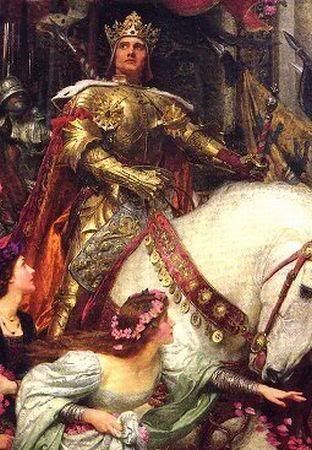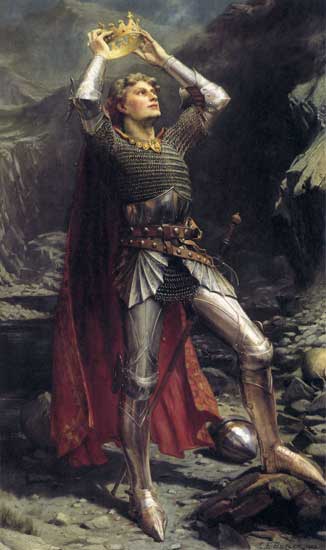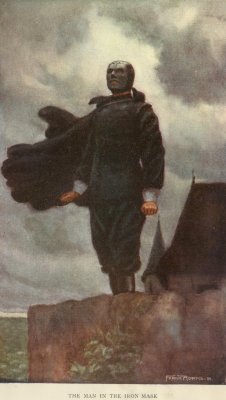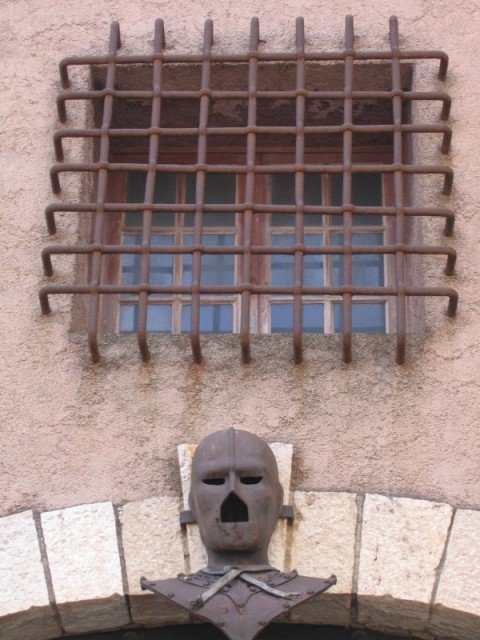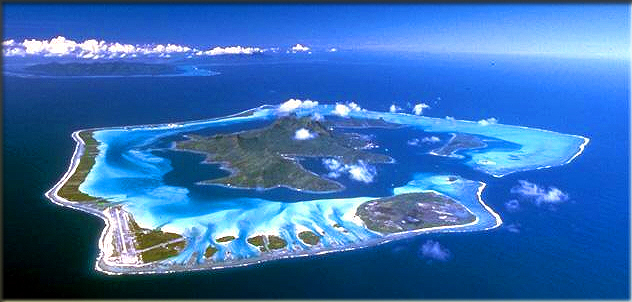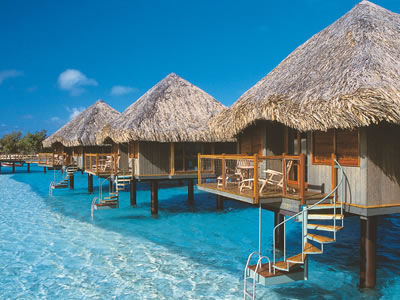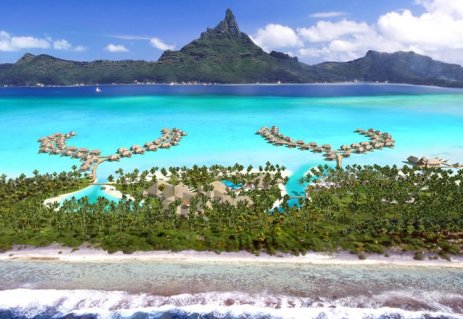
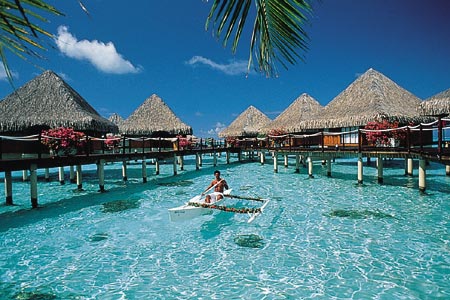




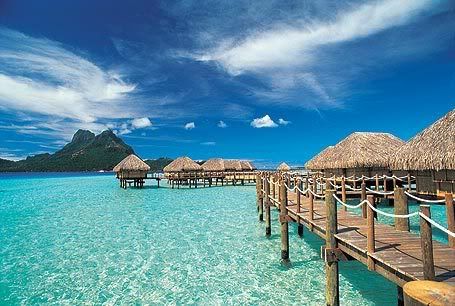


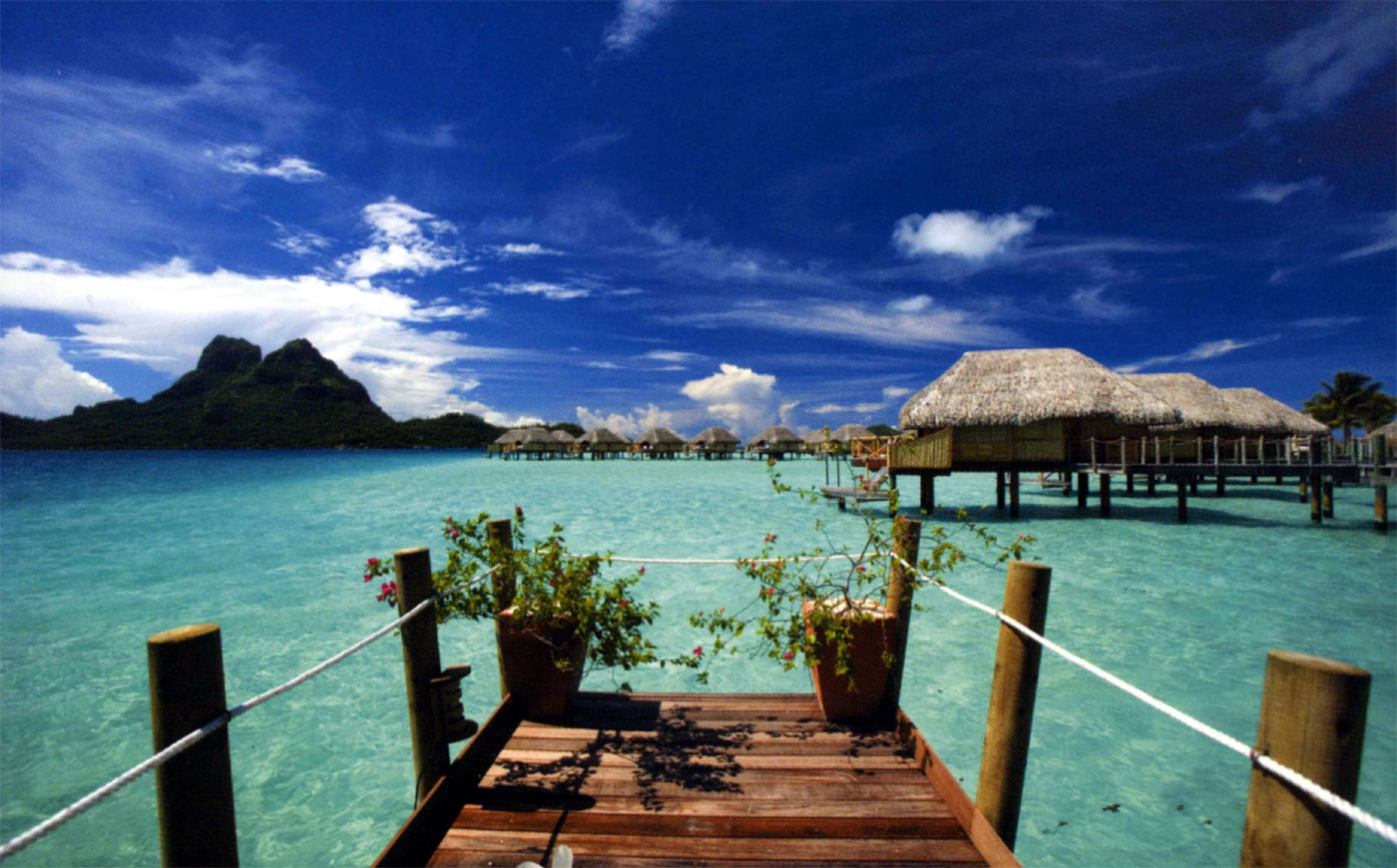
Legendary Tahiti, isle of love, has long been the vision of "la Nouvelle Cythère," the earthly paradise. Explorers Wallis, Bougainville, and Cook all told of a land of spellbinding beauty and enchantment, where the climate was delightful, hazardous insects and diseases unknown, and the islanders, especially the women, among the handsomest ever seen. Rousseau's "noble savage" had been found! A few years later, Fletcher Christian and Captain Bligh acted out their drama of sin and retribution here. The list of famous authors who traveled to Tahiti and wrote about the island reads like a high-school literature course: Herman Melville, Robert Louis Stevenson, Pierre Loti, Rupert Brooke, Jack London, W. Somerset Maugham, Charles Nordhoff and James Norman Hall (the Americans who wrote Mutiny on the Bounty), among others. Exotic images of uninhibited dancers, fragrant flowers, and pagan gods fill the pages. Here, at least, life was meant to be enjoyed. The most unlikely PR man of them all was a once-obscure French painter named Paul Gauguin, who transformed the primitive color of Tahiti and the Marquesas into powerful visual images seen around the world. When WW II shook the Pacific from Pearl Harbor to Guadalcanal, rather than bloodcurdling banzais and saturation bombings, French Polynesia got a U.S. serviceman named James A. Michener, who added Bora Bora to the legend. Marlon Brando arrived in 1961 on one of the first jets to land on Tahiti and his Bounty film attracted thousands of other travelers and adventurers to also make the trip.
French Polynesia consists of five great archipelagos, the Society, Austral, Tuamotu, Gambier, and Marquesas islands, arrayed in chains running from northwest to southeast. The Society Islands are subdivided into the Windwards, or Îles du Vent (Tahiti, Moorea, Maiao, Tetiaroa, and Mehetia), and the Leewards, or Îles Sous-le-Vent (Huahine, Raiatea, Taha'a, Bora Bora, Maupiti, Tupai, Maupihaa/Mopelia, Manuae/Scilly, and Motu One/Bellingshausen).
Together the 35 islands and 83 atolls of French Polynesia total only 3,543 square km in land area, yet they're scattered over a vast area of the southeastern Pacific Ocean, between 7° and 28° south latitude and 131° and 156° west longitude. The capital Papeete (149° west longitude) is actually eight degrees east of Honolulu (157° west longitude). Though Tahiti is only half the size of Corsica in land area, if Papeete were Paris then the Gambiers would be in Romania and the Marquesas near Stockholm. At 5,030,000 square km the territory's 200-nautical-mile exclusive economic zone is by far the largest in the Pacific islands.
There's a wonderful geological diversity to these islands midway between Australia and South America--from the dramatic, jagged volcanic outlines of the Society and Marquesas islands, to the 400-meter-high hills of the Australs and Gambiers, to the low coral atolls of the Tuamotus. All of the Marquesas are volcanic islands, while the Tuamotus are all coral islands or atolls. The Societies and Gambiers include both volcanic and coral types.
Tahiti and French Polynesia abound in things to see and do, including many in the "not to be missed" category. Papeete's colorful morning market and captivating waterfront welcome you to Tahiti, the territory's largest island by far. The 117-km road around Tahiti passes historic monuments, museums, temple ruins, beaches, waterfalls, cliffs, gardens and countless scenic views. Travelers should not pass up the opportunity to take the ferry ride to Moorea and see the island's stunning Opunohu Valley, replete with splendid scenery, lush vegetation, and fascinating archaeological sites. Moorea has the long white beach and brilliant reefs Tahiti lacks, and accommodations are abundant in all price ranges.
Farther afield, an even greater concentration of old Polynesian marae (temples) awaits visitors to Maeva on the enchanting island of Huahine. Visible to the west are the large islands of Raiatea and Taha'a which share a single lagoon well favored by yachties. Raiatea boasts the most sacred Polynesian temple in the Society Islands.
The soaring peaks and blue-green lagoon at Bora Bora have been applauded many times, and neighboring Maupiti offers more of the same, though its pleasures are less well known. All of these islands are easily accessible from Tahiti by boat or plane, a traveler's paradise.
French Polynesia's most spectacular atoll may be Rangiroa in the Tuamotu Islands, where the Avatoru and Tiputa passes offer exciting snorkel rides on the tide flows. The shark feeding and manta ray viewing on Rangiroa, Bora Bora, and other islands, and dolphin encounters on Moorea, are all memorable experiences.
Far to the northeast are the remote Marquesas Islands where the ocean crashes onto unprotected shores. Paul Gauguin sought to escape civilization of the island of Hiva Oa in the Marquesas and the filming of the TV series Survivor on Nuku Hiva in 2002 again brought the group to the attention of the world.
As elsewhere in the South Pacific, scuba diving is the most popular sport among visitors. The best coral and marinelife viewing by far is available in the Tuamotus and serious divers won't go wrong by choosing Rangiroa, the shark- viewing capital of Polynesia. In the warm waters of Polynesia wetsuits are not required.
There's good surfing around Tahiti, Moorea, Huahine, and Raiatea, usually hurricane swells on the north shores from October to March (summer) and Antarctic swells on the south shores from April to September (winter). The summer swells are the same ones that hit Hawaii three or four days earlier and the reef breaks off the north shore of Moorea work better than Tahiti's beach breaks. The most powerful, hollow waves are in winter.
Excellent, easily accessible hiking areas exist on Tahiti, Moorea, and Nuku Hiva. Horseback riding is readily available on Moorea, Huahine, Raiatea, and in the Marquesas with the Huahine and Raiatea operations especially recommended. The Society Islands are a sailor's paradise with numerous protected anchorages and excellent sailing weather, which is why most of French Polynesia's charter yacht operations are concentrated on Raiatea.
The big event of the year is the two-week-long Heiva i Tahiti, which runs from the end of June to Bastille Day (14 July). Formerly known as La Fête du Juillet or the Tiurai Festival (the Tahitian word tiurai comes from the English July), the Heiva originated way back in 1882. Today contestants and participants from all over the territory travel to Tahiti to take part in elaborate processions, competitive dancing and singing, feasting, and partying. There are bicycle, car, horse, and outrigger-canoe races, petanque, archery, and javelin-throwing contests, fire walking, sidewalk bazaars, arts and crafts exhibitions, tattooing, games, and joyous carnivals. Bastille Day itself, which marks the fall of the Bastille in Paris on 14 July 1789 at the height of the French Revolution, features a military parade in the capital. You'll see historical reenactments at Marae Arahurahu, a canoe race along the Papeete waterfront, horse racing at the Pirae track, and traditional dance competitions.
The Moorea Blue Marathon has been held every February since 1988. A traditional Maohi sports festival in late April features javelin throwing, rock lifting, coconut tree climbing, coconut husking, races while carrying loads of fruit, etc. The Te Aito individual outrigger canoe race is held on Tahiti around the end of July. The Hawaiki Nui Va'a outrigger canoe race in early November is a stirring three-day event with canoe teams crossing from Huahine to Raiatea the first day, Raiatea to Taha'a the second, and Taha'a to Bora Bora the third.
Everyone other than French citizens needs a passport to travel to French Polynesia. Citizens of the European Union countries, Norway, Switzerland and Australia get three months without a visa. Citizens of the United States, Canada, New Zealand, Japan, and 13 other countries are granted a one-month stay free upon arrival on Tahiti. Most others must apply at a French diplomatic mission for a visa, but it's usually issued without delay.
The French Pacific franc or Cour de Franc Pacifique (CFP) is legal tender in Tahiti. The value of the CFP is linked to the Euro, so it's a stable currency. A rough way to convert CFP into U.S. dollars would be simply to divide by 100, so CFP 1,000 is US$10, etc.
All banks levy a stiff commission on foreign currency transactions but traveler's checks attract a rate of exchange about 1.5% higher than cash. An alternative are the ATM machines which give a rate slightly better than traveler's checks. Ask your own bank what fees you'll be charged to use ATMs abroad. There have been software problems with the ATMs on Tahiti and it's unwise to be dependent on them.
The domestic air carrier, Air Tahiti, flies to 37 airstrips in every corner of French Polynesia, with important hubs at Papeete (Windward Islands), Bora Bora (Leeward Islands), Rangiroa (western Tuamotus), Hao (eastern Tuamotus), and Nuku Hiva (Marquesas).
To save money, many travelers tour French Polynesia by boat. Ships leave Papeete regularly for the different island groups. The Moorea ferries operate five or six times a day. The cruise to the Marquesas on the passenger-carrying freighter Aranui is highly recommended.
French Polynesia's folkloric le truck provides an entertaining unscheduled passenger service on Tahiti, Huahine, and Raiatea. Passengers sit on long wooden benches in back and there's no problem with luggage. Taxis are overpriced throughout French Polynesia. If you must take one, always verify the fare before getting in. The hitching is still fairly good in French Polynesia.













French Polynesia consists of five great archipelagos, the Society, Austral, Tuamotu, Gambier, and Marquesas islands, arrayed in chains running from northwest to southeast. The Society Islands are subdivided into the Windwards, or Îles du Vent (Tahiti, Moorea, Maiao, Tetiaroa, and Mehetia), and the Leewards, or Îles Sous-le-Vent (Huahine, Raiatea, Taha'a, Bora Bora, Maupiti, Tupai, Maupihaa/Mopelia, Manuae/Scilly, and Motu One/Bellingshausen).
Together the 35 islands and 83 atolls of French Polynesia total only 3,543 square km in land area, yet they're scattered over a vast area of the southeastern Pacific Ocean, between 7° and 28° south latitude and 131° and 156° west longitude. The capital Papeete (149° west longitude) is actually eight degrees east of Honolulu (157° west longitude). Though Tahiti is only half the size of Corsica in land area, if Papeete were Paris then the Gambiers would be in Romania and the Marquesas near Stockholm. At 5,030,000 square km the territory's 200-nautical-mile exclusive economic zone is by far the largest in the Pacific islands.
There's a wonderful geological diversity to these islands midway between Australia and South America--from the dramatic, jagged volcanic outlines of the Society and Marquesas islands, to the 400-meter-high hills of the Australs and Gambiers, to the low coral atolls of the Tuamotus. All of the Marquesas are volcanic islands, while the Tuamotus are all coral islands or atolls. The Societies and Gambiers include both volcanic and coral types.
Tahiti and French Polynesia abound in things to see and do, including many in the "not to be missed" category. Papeete's colorful morning market and captivating waterfront welcome you to Tahiti, the territory's largest island by far. The 117-km road around Tahiti passes historic monuments, museums, temple ruins, beaches, waterfalls, cliffs, gardens and countless scenic views. Travelers should not pass up the opportunity to take the ferry ride to Moorea and see the island's stunning Opunohu Valley, replete with splendid scenery, lush vegetation, and fascinating archaeological sites. Moorea has the long white beach and brilliant reefs Tahiti lacks, and accommodations are abundant in all price ranges.
Farther afield, an even greater concentration of old Polynesian marae (temples) awaits visitors to Maeva on the enchanting island of Huahine. Visible to the west are the large islands of Raiatea and Taha'a which share a single lagoon well favored by yachties. Raiatea boasts the most sacred Polynesian temple in the Society Islands.
The soaring peaks and blue-green lagoon at Bora Bora have been applauded many times, and neighboring Maupiti offers more of the same, though its pleasures are less well known. All of these islands are easily accessible from Tahiti by boat or plane, a traveler's paradise.
French Polynesia's most spectacular atoll may be Rangiroa in the Tuamotu Islands, where the Avatoru and Tiputa passes offer exciting snorkel rides on the tide flows. The shark feeding and manta ray viewing on Rangiroa, Bora Bora, and other islands, and dolphin encounters on Moorea, are all memorable experiences.
Far to the northeast are the remote Marquesas Islands where the ocean crashes onto unprotected shores. Paul Gauguin sought to escape civilization of the island of Hiva Oa in the Marquesas and the filming of the TV series Survivor on Nuku Hiva in 2002 again brought the group to the attention of the world.
As elsewhere in the South Pacific, scuba diving is the most popular sport among visitors. The best coral and marinelife viewing by far is available in the Tuamotus and serious divers won't go wrong by choosing Rangiroa, the shark- viewing capital of Polynesia. In the warm waters of Polynesia wetsuits are not required.
There's good surfing around Tahiti, Moorea, Huahine, and Raiatea, usually hurricane swells on the north shores from October to March (summer) and Antarctic swells on the south shores from April to September (winter). The summer swells are the same ones that hit Hawaii three or four days earlier and the reef breaks off the north shore of Moorea work better than Tahiti's beach breaks. The most powerful, hollow waves are in winter.
Excellent, easily accessible hiking areas exist on Tahiti, Moorea, and Nuku Hiva. Horseback riding is readily available on Moorea, Huahine, Raiatea, and in the Marquesas with the Huahine and Raiatea operations especially recommended. The Society Islands are a sailor's paradise with numerous protected anchorages and excellent sailing weather, which is why most of French Polynesia's charter yacht operations are concentrated on Raiatea.
The big event of the year is the two-week-long Heiva i Tahiti, which runs from the end of June to Bastille Day (14 July). Formerly known as La Fête du Juillet or the Tiurai Festival (the Tahitian word tiurai comes from the English July), the Heiva originated way back in 1882. Today contestants and participants from all over the territory travel to Tahiti to take part in elaborate processions, competitive dancing and singing, feasting, and partying. There are bicycle, car, horse, and outrigger-canoe races, petanque, archery, and javelin-throwing contests, fire walking, sidewalk bazaars, arts and crafts exhibitions, tattooing, games, and joyous carnivals. Bastille Day itself, which marks the fall of the Bastille in Paris on 14 July 1789 at the height of the French Revolution, features a military parade in the capital. You'll see historical reenactments at Marae Arahurahu, a canoe race along the Papeete waterfront, horse racing at the Pirae track, and traditional dance competitions.
The Moorea Blue Marathon has been held every February since 1988. A traditional Maohi sports festival in late April features javelin throwing, rock lifting, coconut tree climbing, coconut husking, races while carrying loads of fruit, etc. The Te Aito individual outrigger canoe race is held on Tahiti around the end of July. The Hawaiki Nui Va'a outrigger canoe race in early November is a stirring three-day event with canoe teams crossing from Huahine to Raiatea the first day, Raiatea to Taha'a the second, and Taha'a to Bora Bora the third.
Everyone other than French citizens needs a passport to travel to French Polynesia. Citizens of the European Union countries, Norway, Switzerland and Australia get three months without a visa. Citizens of the United States, Canada, New Zealand, Japan, and 13 other countries are granted a one-month stay free upon arrival on Tahiti. Most others must apply at a French diplomatic mission for a visa, but it's usually issued without delay.
The French Pacific franc or Cour de Franc Pacifique (CFP) is legal tender in Tahiti. The value of the CFP is linked to the Euro, so it's a stable currency. A rough way to convert CFP into U.S. dollars would be simply to divide by 100, so CFP 1,000 is US$10, etc.
All banks levy a stiff commission on foreign currency transactions but traveler's checks attract a rate of exchange about 1.5% higher than cash. An alternative are the ATM machines which give a rate slightly better than traveler's checks. Ask your own bank what fees you'll be charged to use ATMs abroad. There have been software problems with the ATMs on Tahiti and it's unwise to be dependent on them.
The domestic air carrier, Air Tahiti, flies to 37 airstrips in every corner of French Polynesia, with important hubs at Papeete (Windward Islands), Bora Bora (Leeward Islands), Rangiroa (western Tuamotus), Hao (eastern Tuamotus), and Nuku Hiva (Marquesas).
To save money, many travelers tour French Polynesia by boat. Ships leave Papeete regularly for the different island groups. The Moorea ferries operate five or six times a day. The cruise to the Marquesas on the passenger-carrying freighter Aranui is highly recommended.
French Polynesia's folkloric le truck provides an entertaining unscheduled passenger service on Tahiti, Huahine, and Raiatea. Passengers sit on long wooden benches in back and there's no problem with luggage. Taxis are overpriced throughout French Polynesia. If you must take one, always verify the fare before getting in. The hitching is still fairly good in French Polynesia.






























